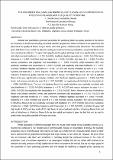| dc.description.abstract | Reliable and quantifiable green leaf parameters for predicting black tea quality potential of tea bushes at the single bush stage are necessary to shorten tea breeding and clonal selection programmes. Green leaf flavan-3-ols (catechins) and plain black tea quality of 11 popular Kenyan clones were determined. The individual green leaf flavan-3-ols, and all the black tea quality parameters and sensory evaluations, except total flavan-3-ols were significantly different. The green leaf epigallocatechin gallate (EGCg) levels significantly correlated with black tea total theaflavin (r = 0.749, P ⩽ 0.007), liquor brightness (r = 0.898, P ⩽ 0.0001) levels and Taster B (r = 0.595, P ⩽ 0.051) sensory evaluations, and negatively with thearubigins (r = −0.652, P ⩽ 0.027), while green leaf epicatechin (EC) levels correlated positively with thearubigins (r = 0.694, P ⩽ 0.016) and negatively with theaflavin digallate equivalent (r = −0.751, P ⩽ 0.007), and sensory evaluation by Taster A (r = −0.785, P ⩽ 0.003) and Taster B (r = −0.679, P ⩽ 0.020). Thus, high levels of EGCg and low levels of EC in tea green leaf can be used as indicators of plain black tea quality potential of tea plants. The sum of gallated flavan-3-ols correlated significantly and positively with theaflavin digallate equivalent (r = 0.669, P ⩽ 0.022) levels, but negatively correlated with the black tea thearubigins (r = −0.582, P ⩽ 0.052). The sum of trihydroxyflavan-3-ols (gallocatechins) positively correlated with brightness (r = 0.750, P ⩽ 0.007), and sensory evaluation by Taster A (r = 0.656, P ⩽ 0.026), but negatively with thearubigins (r = −0.641, P ⩽ 0.031). However, the sum of dihydroxyflavan-3-ols (simple catechins) correlated positively with thearubigins (r = 0.716, P ⩽ 0.012) and negatively with total theaflavins (r = −0.6694, P ⩽ 0.022), theaflavin digallate equivalent (r = −0.631, P ⩽ 0.035), brightness (r = −0.843, P ⩽ 0.001), Taster A (r = −0.775, P ⩽ 0.004) and Taster B (r = −0.638, P ⩽ 0.032) sensory evaluation. The ratios of trihydroxyflavan-3-ols to dihydroxyflavan-3-ols correlated positively with brightness (r = 0.678, P ⩽ 0.020) and sensory evaluation of Taster A (r = 0.667, P ⩽ 0.023), but negatively with thearubigins (r = −0.697, P ⩽ 0.015). In addition to green leaf high levels of EGCg and low levels of EC, high levels of the sum of gallated catechins, trihydroxyflavan-3-ols, and the ratio of trihydroxyflavan-3-ols to dihydroxyflavan-3-ols are parameters in green tea leaf that may be used in predicting plain black tea quality potential of Kenyan tea clones | en_US |

